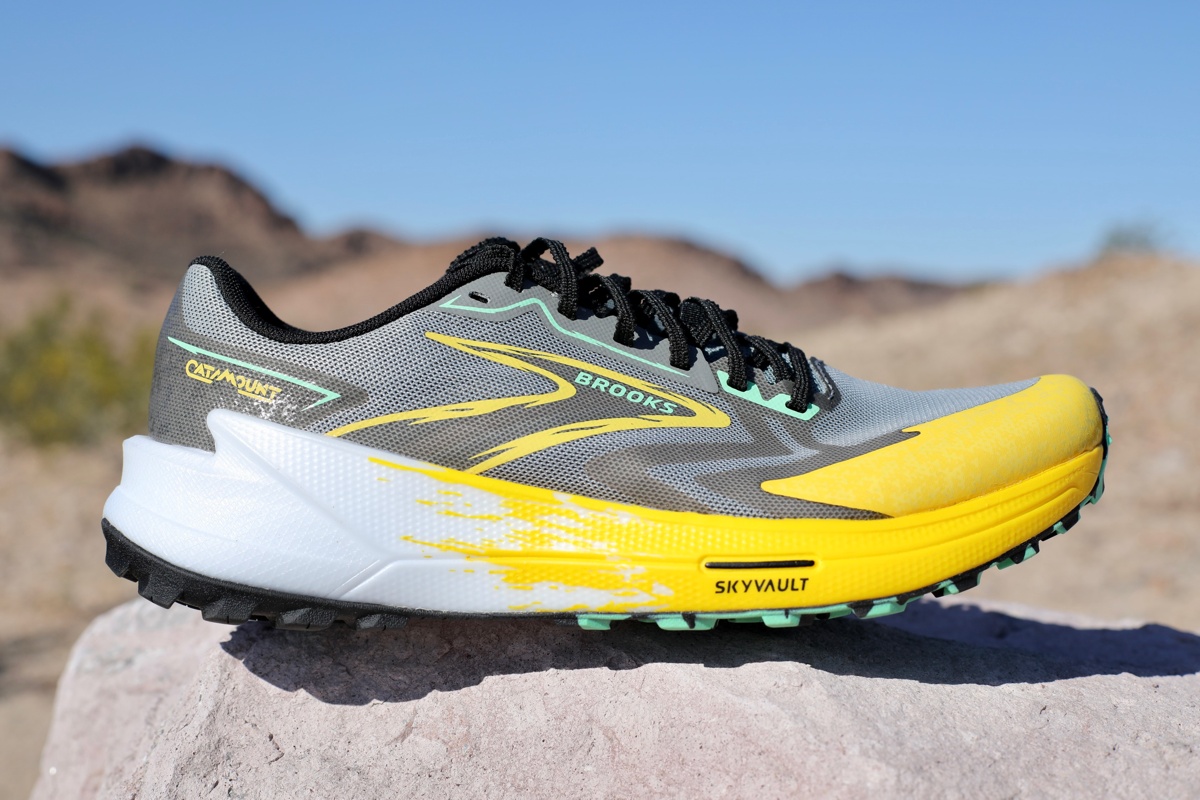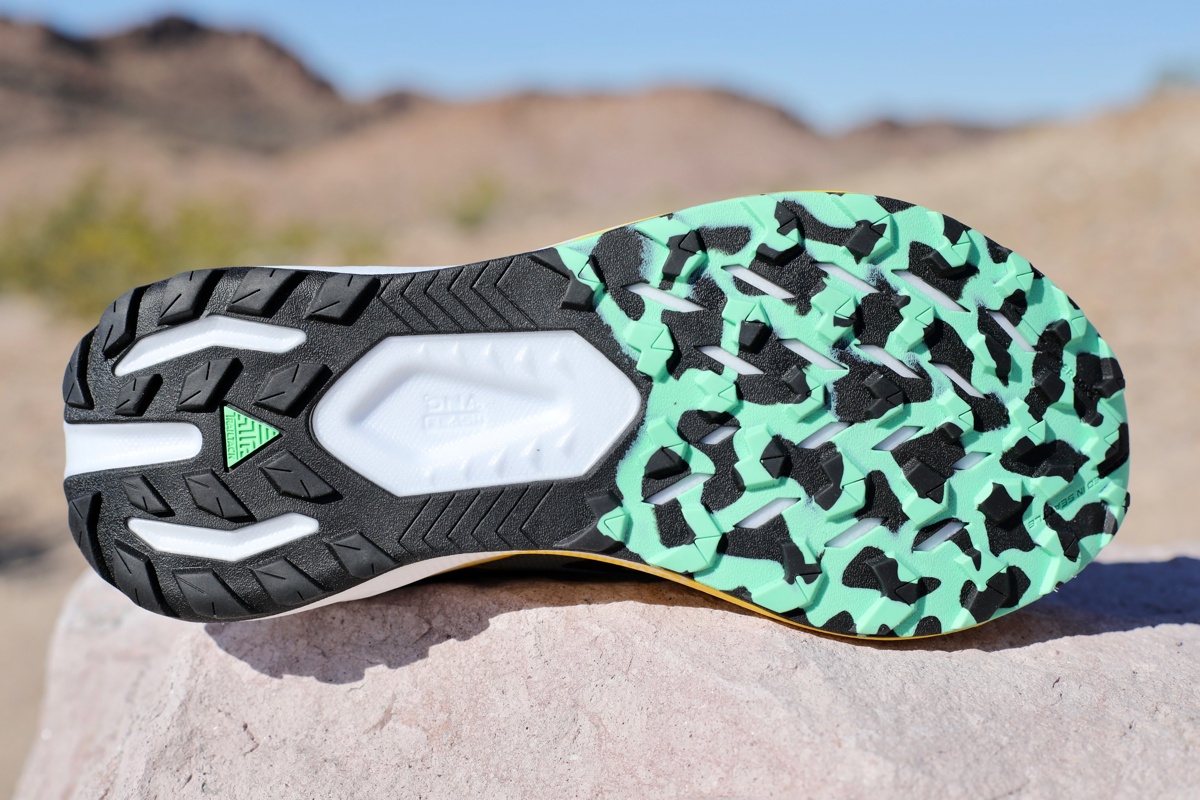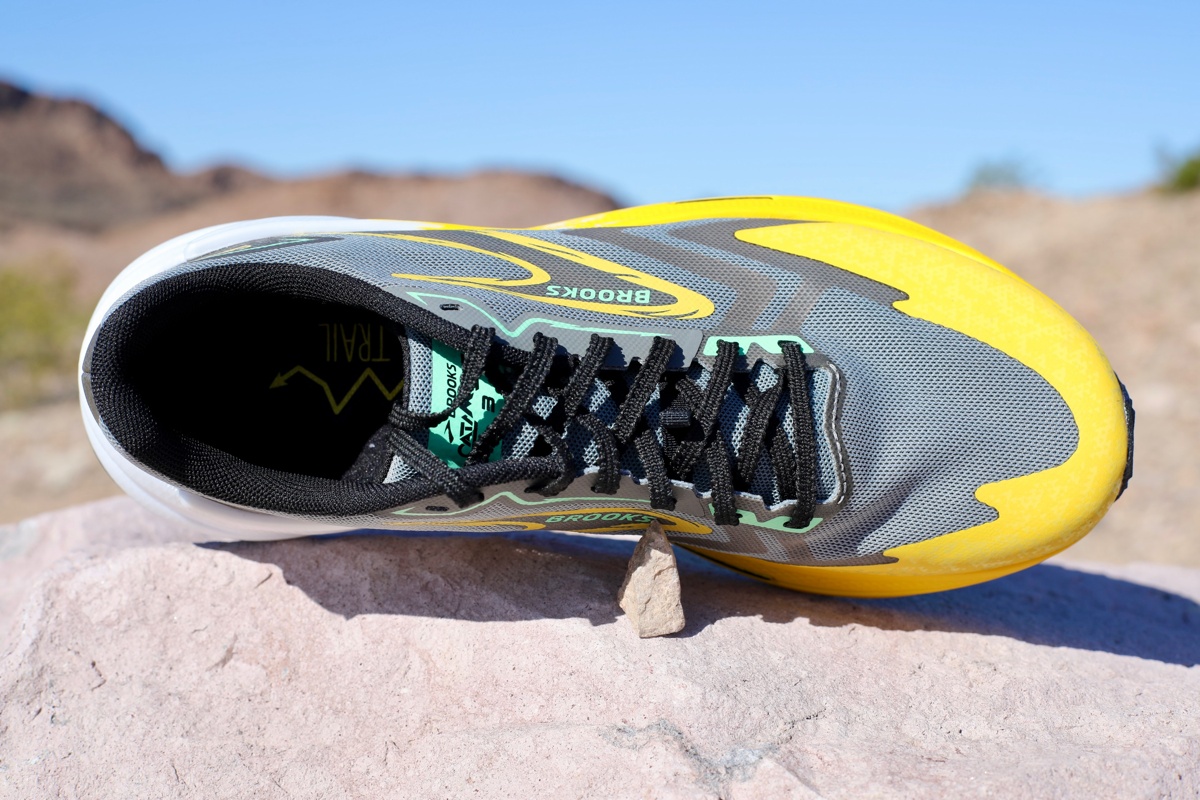For the latest on the Catamount family, read our full Brooks Catamount 4 review.
Our Favorite Trail Running Shoes
Check out our Best Trail Running Shoes buyer’s guide to learn about our current favorite trail running shoes!
Brooks Catamount 3 Review
Before diving into the review of the Brooks Catamount 3 ($170), let’s take a moment to reflect on its predecessor, the OG Brooks Catamount – see our original Brooks Catamount review. I had a fondness for that shoe. However, prolonged runs exceeding three hours often resulted in foot soreness, prompting me to search for an alternative, eventually landing on The North Face Summit Vectiv Sky – see our The North Face Summit Vectiv Sky review. Consequently, I missed the opportunity to experience the Brooks Catamount 2.
Intrigued by the reviews of the Catamount 2, I was eager to assess whether the Catamount 3 fulfilled all my criteria for an ideal trail running shoe: lightweight, moderate traction, and responsive, yet offering sufficient cushioning to prevent soreness during extended runs.
The Brooks Catamount 3 boasts impressive specifications tailored to trail runners looking for a lightweight and fast trail shoe. With a claimed midsole height of 16 millimeters in the forefoot and 22 millimeters in the heel, the Catamount 3 provides modest cushioning and support to tackle rugged terrains, while the midsole drop of 6 millimeters promotes a natural stride. With a claimed weight of 8.4 ounces (238 grams) for U.S. women’s size 8.5 and 9.4 ounces (266 grams) for a U.S. men’s 9, the Brooks Catamount 3 strikes a balance between durability and agility, making it a versatile choice for trail runners seeking performance and comfort.
Like its predecessors, we’ve deemed the Brooks Catamount 3 worthy of inclusion in our Best Trail Running Shoes guide.
Shop the Women's Brooks Catamount 3Shop the Men's Brooks Catamount 3
Brooks Catamount 3 Upper
The Brooks Catamount 3 introduces significant updates to its upper construction, promising enhanced performance and comfort on the trails. Building upon the foundation laid by its predecessors, the Catamount 3 boasts a revamped design that prioritizes flexibility, lightweight feel, and adaptability to various terrains.
Unlike the Catamount 2, which featured a dual-layer fabric upper, the Catamount 3 opts for a single, flexible, and lightweight single-layer TPEE mesh for durability and comfort. This streamlined construction allows the materials to conform more seamlessly to the foot’s natural movements, facilitating a smoother experience during uphill climbs and lateral maneuvers.
The snug fit of this shoe feels refreshing for a Brooks model, as the brand often leans towards a roomier fit. I experienced a sense of security with my foot comfortably nestled in the shoe, allowing me to tighten the laces without creating any discomfort or hot spots. Even on technical trails, my foot remained firmly in place without any sensation of looseness or movement.
The laces on the Catamount 3 are an upgrade over the Catamount 2. Brooks opted for textured, almost braided, laces. They remained tight and tied during all of my runs. Plus, the lace bungee on the tongue of the shoe kept them from flapping around.
Similar to iRunFar’s review of the Catamount 2, I found that the Catamount 3 toebox was slightly shallow and my big toe barely rubbed up against the top. It didn’t cause any major issues, and seemed to improve as I broke the shoe in.
Brooks Catamount 3 Midsole
The Brooks Catamount 3 is similar to the Catamount 2 in that it also features Brooks’ two unique technologies in the midsole — DNA FLASH and the SkyVault trail plate.
The DNA FLASH midsole technology is infused with nitrogen, making it lightweight and providing runners with a responsive and agile experience on trails. While I did find the shoe to be more comfortable and more responsive than the original Catamount, it still felt like I wanted more “oomph” from this shoe.
It’s important to note that the shoe may feel harsher when used on roads or gravel paths. Unlike shoes with similar cushioning, the shoe doesn’t provide the same pop on these surfaces. At times I found the shoe to be stiff rather than responsive.
The SkyVault trail plate enhances uphill efficiency, which Brooks claims will help runners maintain a brisk pace and easily conquer peaks. I’d also say training on hills will do that as well — that’s what I tell myself.
I can’t say I noticed a huge difference to previous iterations on the uphills. The shoe is lightweight, with a claimed weight of 9.4 ounces (266 grams) for U.S. men’s size 9, making going uphill feel much less arduous.
With a claimed midsole height of 22 millimeters at the heel and 16 millimeters at the toe, and a midsole drop of 6 millimeters, the Catamount 3 falls right in the middle of the cushion scale, and I found that the shoe provided a welcomed trail feel. I wasn’t disconnected from what I was running over, but I was protected from most of the bumps.
Additionally, the base or platform width of the shoe was just the perfect size. I found this helped the shoe give me stability without being corrective.
Brooks Catamount 3 Outsole
The Brooks Catamount 3 integrates a TrailTack Green rubber outsole that exemplifies the brand’s commitment to sustainability and performance. Crafted with 25% recycled content, this innovative outsole not only reduces environmental impact, but Brooks claims it also delivers exceptional traction on various surfaces, whether wet or dry.
Getting tested in the winter, the Catamount 3 went through the wringer. I used these shoes on the road, gravel paths, ice, snow, bike paths, rough trails, and dare I say it: the treadmill. (It was −25 Fahrenheit out, so this was a last resort.)
I was worried the outsole would get worn out faster than normal, but was surprised at its durability. The shoe’s outsole is still in great condition, and I haven’t noticed any decrease in traction.
The Catamount’s 3.5-millimeter lugs aren’t overly aggressive, yet they managed to keep me secure and confident, even on snowy trails.
Brooks Catamount 3 Overall Impressions
The Brooks Catamount 3 emerges as a standout all-purpose trail shoe, skillfully balancing traction, cushioning, and modest responsiveness. Notably, it is not overly corrective or excessively cushioned — offering stability, a snug fit, and commendable performance across various trails. It is a perfect choice for those looking for a lightweight and fast trail shoe.
While Brooks suggests that the shoe is best suited for 50k to 100k races, I feel that the 50k distance might be pushing the upper limit for me. Like the feedback from reviewers of the Catamount 2, I also encountered some foot soreness during longer runs with the Catamount 3. Still, we deem the Catamount 3 worthy of being one of our favorites trail shoes in our Best Trail Running Shoes guide.
Shop the Women's Brooks Catamount 3Shop the Men's Brooks Catamount 3
Call for Comments
- Have you tried the Brooks Catamount 3? What were your impressions?
- How do you think it compares with previous iterations of the shoe?
Our Favorite Trail Running Shoes
Check out our Best Trail Running Shoes article to learn about our current favorite trail running shoes!





